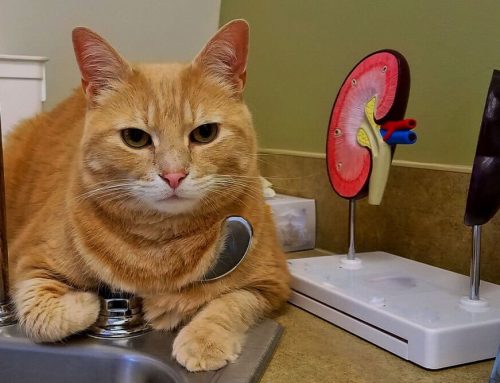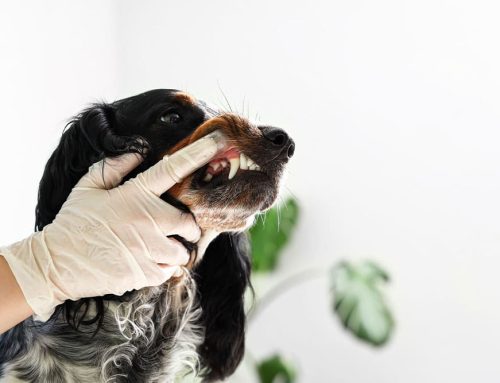Allergies affect numerous pets, but many pet owners have misconceptions about these conditions. Our team at MountainView Veterinary Hospital wants to help by providing accurate information about pet allergies, to ensure your pet gets the care they need.
Misconception #1: Most allergic pets are reacting to their food.
Truth: Food allergies are uncommon in pets, affecting only about 0.2% of dogs and 0.1% of cats. Flea and environmental allergies are much more common.
Misconception #2: I have never seen a flea on my pet, so they can’t have a flea allergy.
Truth: Fleas are the most common external parasite in pets, and many pets are allergic to the flea’s saliva, which means that a bite from only one flea can cause a significant reaction, resulting in signs that include excessive scratching, chewing, biting, and licking, and hair loss and skin lesions on their back, thighs, abdomen, and around their tail. Your pet’s continuous grooming can remove all fleas from their coat, so you cannot see any flea evidence.
Misconception #3: A flea bath will eradicate my pet’s flea problem.
Truth: Your pet’s flea allergy can be remedied only by completely eradicating fleas from your pet’s coat and environment. This process can be extensive, since flea eggs can hatch and reinfest areas after the adult fleas have been killed. Steps to remove the fleas include:
- Bathing your pet — Bathe your pet in an appropriate shampoo to kill the fleas, and use a flea comb to ensure you remove all fleas.
- Washing your pet’s bedding — Wash or discard your pet’s bedding, where fleas frequently thrive.
- Vacuuming the area — Use a high-powered vacuum on the carpet and upholstery in your home.
- Treating the area — Spray hard surfaces with an appropriate insecticide to kill the fleas at all life stages—you may have to spray multiple times over several days to eradicate all fleas. Also, ensure you treat your yard if your pet spends time outside.
- Preventing fleas — Ensure your pet remains on a flea prevention medication year round.
Misconception #4: I can fix my pet’s allergies by switching them to a grain-free diet
Truth: Pets who are allergic to their food are typically reacting to the protein source, commonly chicken, eggs, beef, and dairy. The only way to determine the cause of the problem is a food elimination trial, which can be arduous, and includes:
- Finding the right diet — Your pet will be switched to a diet that doesn’t contain any ingredients from their previous diet. This can be accomplished by finding a novel diet that contains ingredients, such as kangaroo or buffalo, that they’ve never eaten, or by switching them to a hydrolyzed diet that has a protein source broken down into such tiny pieces that the body no longer recognizes them.
- Staying the course — Your pet will have to remain on this diet for at least eight weeks, during which they must not ingest any food containing ingredients from their previous diet, including table scraps, treats, and medicated chews.
- Diagnosing a food allergy — If your pet’s signs improve on the trial diet, they will be switched back to their original diet to determine if the food was causing their reaction. If their signs return when they go back on the original diet, a food allergy is diagnosed.
- Determining the culprit — Once your pet is back on the hypoallergenic diet, they can be fed individual ingredients from their previous diet to determine what food should be banned from their diet.
Misconception #5: Allergy testing can diagnose my pet’s allergy.
Truth: Allergy testing is a tool used to diagnose and treat atopic pets who are allergic to environmental allergens, such as molds, pollen, weeds, dust mites, and pet dander. Intradermal skin tests or blood tests are used to determine the allergens causing the pet’s problem, and this information is used for immunotherapy. This involves administering increasing allergen doses to desensitize the pet to the problematic substance. While this therapy can take 6 to 12 months to be effective, the majority of pets respond positively.
Misconception #6: Antihistamines will control my pet’s environmental allergies.

Truth: Antihistamines aren’t typically effective in pets. Treatment usually requires a multimodal approach that includes:
- Bathing — Weekly bathing can remove allergens from your pet’s skin and coat and soothe inflamed skin. More frequent bathing can cause irritation, so wipe down your pet’s hair coat, abdomen, and limbs with wet towels between baths.
- Corticosteroids — Steroids are strong anti-inflammatories that are commonly used to help control signs in the acute stages. While these medications work well, they can have concerning side effects if used in large doses or for extended periods.
- Anti-itch medications — Many products on the market can decrease your pet’s itchiness, and our veterinary professionals will determine the best one for your pet.
- Omega-3 fatty acids — Omega-3 fatty acid supplements can improve your pet’s skin health and decrease inflammation.
- Immunotherapy — Immunotherapy is considered the gold standard treatment for atopy.
Pet allergies are problematic, but knowing the facts can help ensure your pet gets the care they need. If you have an itchy pet, contact our team at MountainView Veterinary Hospital, so we can determine what is making them itch and relieve their distress.









Leave A Comment